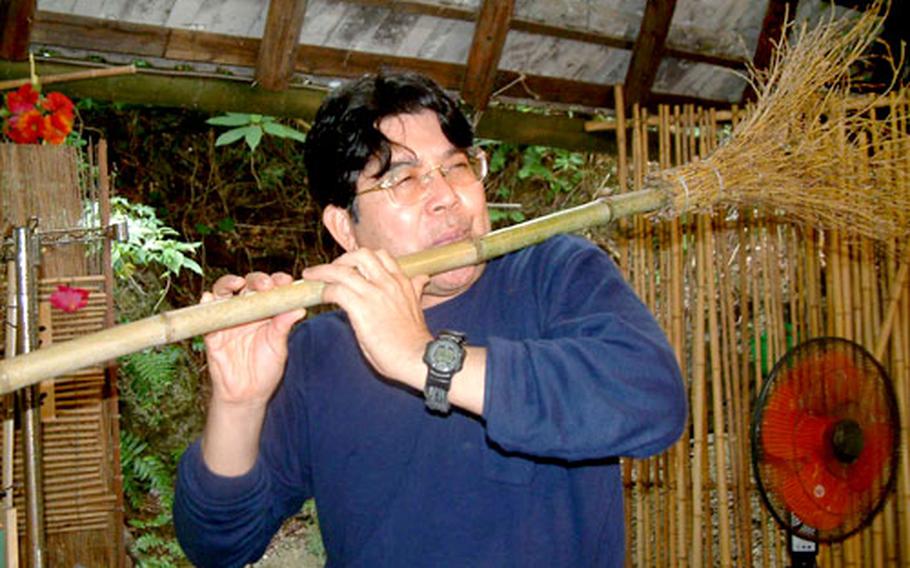
Kinya Tamaki plays a version of “Amazing Grace” on this bamboo broom flute. He sells handmade slide whistles and flutes at the Ryukyu Mura folk village. (David Allen / S&S)
ONNA, Okinawa — This is how Okinawa used to be, before war and American occupation transformed the island.
Ryukyu Mura is a carefully reconstructed village on the west coast of Okinawa, a few miles north of Kadena Air Base and Torii Station. But though near in distance, it is a century removed in time.
Nestled at the foot of jungle-covered Takoyama Mountain, the folk village is made up of 10 century-old houses that were disassembled and moved from villages throughout the Ryukyu archipelago. Here, the wooden structures were rebuilt and capped with the original red tile roofs and surrounded by walls of coral limestone.
Today they house exhibits and displays of an ancient culture that adopted the styles and rituals of the lands from Korea to Southeast Asia, places visited by the once-active seagoing traders of the Kingdom of the Ryukyus.
In a way, this is Okinawa’s Williamsburg. The Ryukyu Mura staff members wear period costumes and remain in character as they engage in activities from weaving and dying traditional Okinawa fabrics to carving flutes from bamboo and creating distinctive Okinawan pottery.
In the Nakasone House, a well-to-do farmer’s house originally built in the Zakimi area of Yomitan about 180 years ago, weaver Setsuko Nakama sits at a loom, weaving a colorful piece of hanaui, the local textile. Visitors to Ryukyu Mura can weave their own swatches — from a coaster for drinks to a small table centerpiece.
Further down the lane, past the replica of a tree house that the original inhabitants of the islands lived in centuries ago, is the Hanshiro House, a farmer’s wooden home dating from 1893 in the Shioya area of Onna. As visitors approach, they are greeted with the melodic strings of a traditional sanshin, sometimes referred to as an Okinawan banjo, strummed by a grandmotherly woman sitting on the floor.
On the other side of the building, which has external walls that roll open to welcome in the sea breeze, Tsuru Higa, 86, offers visitors homemade Okinawa doughnuts — balls of dough cooked in a huge vat of boiling oil in the kitchen stocked with typical 19th-century implements.
A rooster pacing the alley separating the goat pen from the house adds his crows and clucks to the sanshin strumming.
The next building is a small shrine, where visitors place yen coins and prayers printed on paper into the growling mouth of a shisha, one of the stone lions guarding the entrances of buildings on Okinawa. Shishas are believed to have come to Okinawa from China and are usually paired, one with an open mouth to scare away the evil spirits and one with a closed mouth to keep in the good.
Nearby, a tourist couple from Tokyo sample chilled coconut juice sipped from the husk and coconut sashimi. As other visitors sample Okinawa soba, a thick noodle soup, and other island fare, the lilt of a flute carved from bamboo entices others to try their own skills at playing homemade slide whistles. Flutist Kinya Tamaki smiles, puts his flute down, and grabs a broom, protesting to the disappointing groans of his audience that he must sweep up his shop.
And then, with another grin, he raises the end of the bamboo broom handle to his lips and plays “Amazing Grace.”
Music is a large part of the Ryukyu Mura experience. The strings of the sanshin are played continuously through the park’s PA system and there are frequent performances of taiko drummers and folk dancers on the village stage.
Near the end of the walking tour, visitors can watch potters make traditional Okinawan dinnerware and, of course, shishas — all of which can be purchased as keepsakes.
And in a courtyard just outside, a farmer uses a switch to encourage a slow-moving black bull to walk in a circle, turning a stone wheel mill that grinds sugar cane stalks. Candy made from the brown sugar is also available for sale in the market that marks the entrance and exit to Ryukyu Mura.
For an extra 500 yen, visitors can rent a traditional Ryukyuan kimono and take their own pictures or pay an extra 1,100 yen to watch a mongoose attack a poisonous habu snake.
Ryukyu Mura is open daily from 8:30 a.m. to 5:30 p.m., with no admittance after 5 p.m. The entrance fee is 840 yen for adults, 730 yen for high school students and 420 yen for children ages 3 to 15.
To get there: From U.S. bases in central Okinawa, take Highway 58 north through Yomitan and turn left at the Ryukyu Mura sign just before Onna. The road will take you right to the entrance of the folk village.
Chiyomi Sumida contributed to this report.